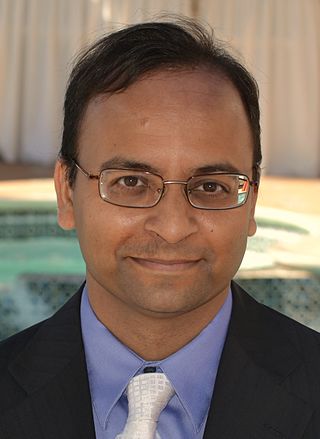
RIPEMD is a family of cryptographic hash functions developed in 1992 and 1996. There are five functions in the family: RIPEMD, RIPEMD-128, RIPEMD-160, RIPEMD-256, and RIPEMD-320, of which RIPEMD-160 is the most common.
In cryptography, a random oracle is an oracle that responds to every unique query with a (truly) random response chosen uniformly from its output domain. If a query is repeated, it responds the same way every time that query is submitted.

In cryptography, DES-X is a variant on the DES symmetric-key block cipher intended to increase the complexity of a brute-force attack. The technique used to increase the complexity is called key whitening.
In cryptography, the strong RSA assumption states that the RSA problem is intractable even when the solver is allowed to choose the public exponent e (for e ≥ 3). More specifically, given a modulus N of unknown factorization, and a ciphertext C, it is infeasible to find any pair (M, e) such that C ≡ M e mod N.
Kleptography is the study of stealing information securely and subliminally. The term was introduced by Adam Young and Moti Yung in the Proceedings of Advances in Cryptology – Crypto '96. Kleptography is a subfield of cryptovirology and is a natural extension of the theory of subliminal channels that was pioneered by Gus Simmons while at Sandia National Laboratory. A kleptographic backdoor is synonymously referred to as an asymmetric backdoor. Kleptography encompasses secure and covert communications through cryptosystems and cryptographic protocols. This is reminiscent of, but not the same as steganography that studies covert communications through graphics, video, digital audio data, and so forth.

Serge Vaudenay is a French cryptographer and professor, director of the Communications Systems Section at the École Polytechnique Fédérale de Lausanne
In cryptography, a password-authenticated key agreement method is an interactive method for two or more parties to establish cryptographic keys based on one or more party's knowledge of a password.
In cryptography, concrete security or exact security is a practice-oriented approach that aims to give more precise estimates of the computational complexities of adversarial tasks than polynomial equivalence would allow. It quantifies the security of a cryptosystem by bounding the probability of success for an adversary running for a fixed amount of time. Security proofs with precise analyses are referred to as concrete.
The Diffie–Hellman problem (DHP) is a mathematical problem first proposed by Whitfield Diffie and Martin Hellman in the context of cryptography. The motivation for this problem is that many security systems use one-way functions: mathematical operations that are fast to compute, but hard to reverse. For example, they enable encrypting a message, but reversing the encryption is difficult. If solving the DHP were easy, these systems would be easily broken.
A group signature scheme is a method for allowing a member of a group to anonymously sign a message on behalf of the group. The concept was first introduced by David Chaum and Eugene van Heyst in 1991. For example, a group signature scheme could be used by an employee of a large company where it is sufficient for a verifier to know a message was signed by an employee, but not which particular employee signed it. Another application is for keycard access to restricted areas where it is inappropriate to track individual employee's movements, but necessary to secure areas to only employees in the group.
Alfred Menezes is co-author of several books on cryptography, including the Handbook of Applied Cryptography, and is a professor of mathematics at the University of Waterloo in Canada.
Digital credentials are the digital equivalent of paper-based credentials. Just as a paper-based credential could be a passport, a driver's license, a membership certificate or some kind of ticket to obtain some service, such as a cinema ticket or a public transport ticket, a digital credential is a proof of qualification, competence, or clearance that is attached to a person. Also, digital credentials prove something about their owner. Both types of credentials may contain personal information such as the person's name, birthplace, birthdate, and/or biometric information such as a picture or a finger print.
Secure two-party computation (2PC) a.k.a. Secure function evaluation is sub-problem of secure multi-party computation (MPC) that has received special attention by researchers because of its close relation to many cryptographic tasks. The goal of 2PC is to create a generic protocol that allows two parties to jointly compute an arbitrary function on their inputs without sharing the value of their inputs with the opposing party. One of the most well known examples of 2PC is Yao's Millionaires' problem, in which two parties, Alice and Bob, are millionaires who wish to determine who is wealthier without revealing their wealth. Formally, Alice has wealth , Bob has wealth , and they wish to compute without revealing the values or .
Non-interactive zero-knowledge proofs are cryptographic primitives, where information between a prover and a verifier can be authenticated by the prover, without revealing any of the specific information beyond the validity of the statement itself. This function of encryption makes direct communication between the prover and verifier unnecessary, effectively removing any intermediaries. The core trustless cryptography "proofing" involves a hash function generation of a random number, constrained within mathematical parameters determined by the prover and verifier.
In cryptography, the Fiat–Shamir heuristic is a technique for taking an interactive proof of knowledge and creating a digital signature based on it. This way, some fact can be publicly proven without revealing underlying information. The technique is due to Amos Fiat and Adi Shamir (1986). For the method to work, the original interactive proof must have the property of being public-coin, i.e. verifier's random coins are made public throughout the proof protocol.
In cryptography, server-based signatures are digital signatures in which a publicly available server participates in the signature creation process. This is in contrast to conventional digital signatures that are based on public-key cryptography and public-key infrastructure. With that, they assume that signers use their personal trusted computing bases for generating signatures without any communication with servers.

Amit Sahai is an American computer scientist. He is a professor of computer science at UCLA and the director of the Center for Encrypted Functionalities.
Dmitry Khovratovich is a cryptographer, currently a Lead Cryptographer for the Dusk Network, researcher for the Ethereum Foundation, and member of the International Association for Cryptologic Research. He developed, together with Alex Biryukov, the Equihash proof-of-work algorithm which is currently being used as consensus mechanism for the Zcash cryptocurrency, and the Argon2 key derivation function, which won the Password Hashing Competition in July 2015.
Brent R. Waters is an American computer scientist, specializing in cryptography and computer security. He is currently a professor of Computer Science at the University of Texas at Austin.

Orr Dunkelman is an Israeli cryptographer and cryptanalyst, currently a professor at the University of Haifa Computer Science department. Dunkelman is a co-director of the Center for Cyber Law & Privacy at the University of Haifa and a co-founder of Privacy Israel, an Israeli NGO for promoting privacy in Israel.




